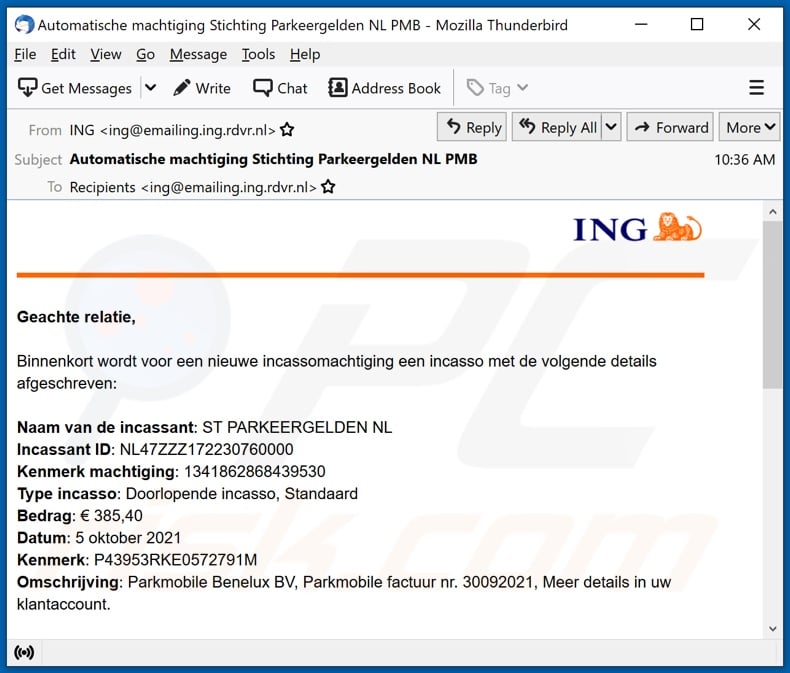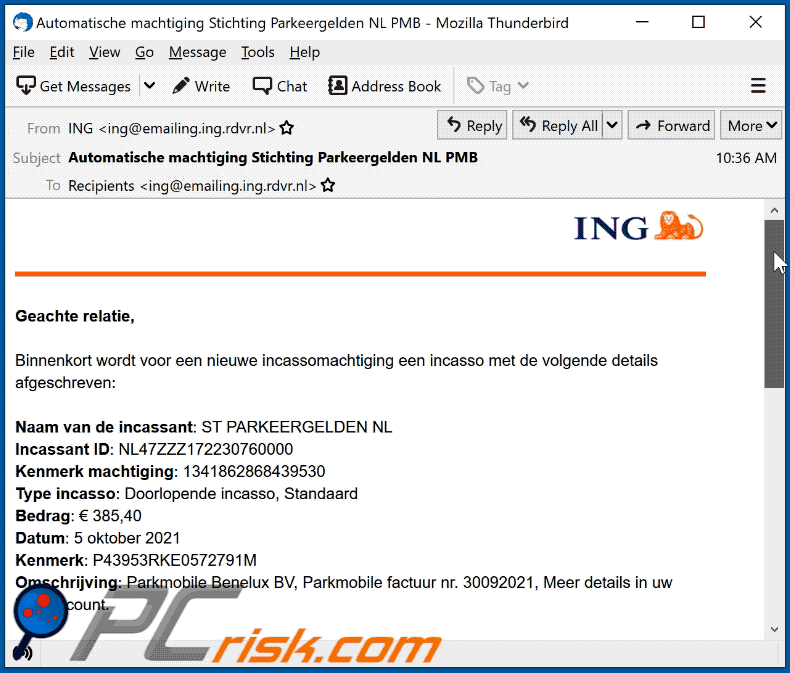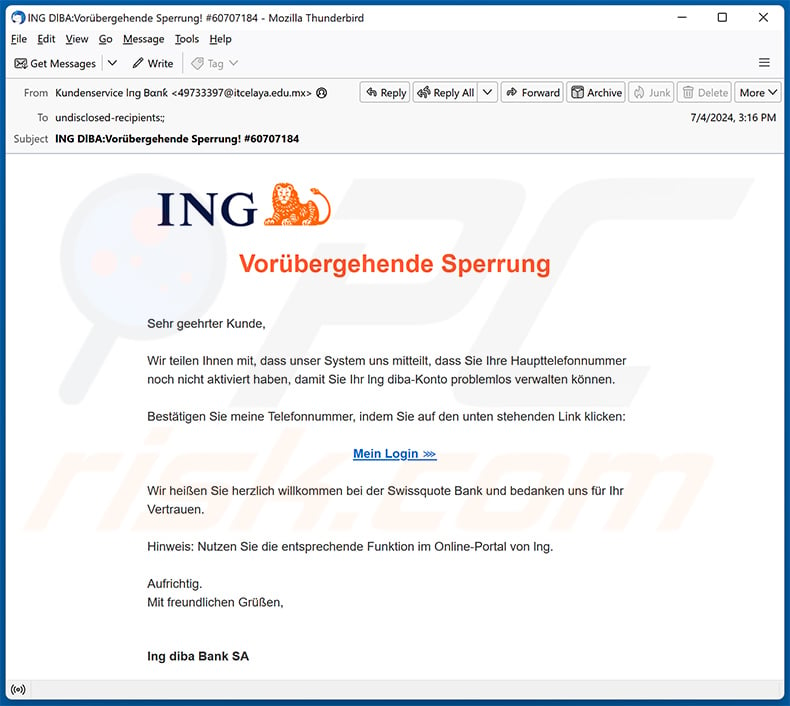Get free scan and check if your device is infected.
Remove it nowTo use full-featured product, you have to purchase a license for Combo Cleaner. Seven days free trial available. Combo Cleaner is owned and operated by RCS LT, the parent company of PCRisk.com.
What is "ING Bank email scam"?
"ING Bank email scam" refers to a spam campaign. The letters sent through this campaign are in Dutch and supposedly relate to parking fees. It must be emphasized that all of the information provided by these emails is false, and the legitimate entities mentioned - are not associated with the scam letters.

"ING Bank email scam" in detail
According to a rough translation, the "ING Bank" scam emails claim that there is a 385.40 EUR parking fee debit. The letters then inquire whether the sum is correct and state that if a direct transfer has already taken place - it cannot be reversed. The emails also contain other information, concerning why the fake email was received and what content such letters should and should not have.
Scam emails like these "ING Bank" letters typically operate as phishing scams. In other words, they aim to obtain sensitive information by tricking users into disclosing it.
Targeted data includes: account log-in credentials (e.g., online banking, e-commerce, email, social networking, social media, and usernames/passwords of other platforms), personally identifiable details, credit card numbers, etc. The stolen information is then used to generate revenue.
Finance-related accounts can be used to make fraudulent transactions and/or online purchases. Scammers can use social accounts to steal the owner's identity and ask their contacts for loans or to proliferate malware (by sharing malicious files/links). Personal information can be sold to third-parties or used to create personalized scams.
Furthermore, such emails often request users to make bogus payments (e.g., for transactions or their reversal, subscriptions, registration, shipping, etc.). What is more, scammers can ask users to pay using dubious payment gateways, which record information provided to them.
In summary, by trusting the "ING Bank" scam emails, users can experience severe privacy issues, financial losses, and even identity theft.
| Name | ING Bank Email Scam |
| Threat Type | Phishing, Scam, Social Engineering, Fraud |
| Fake Claim | Scam emails claim that recipients have a parking fee debit pending. |
| Symptoms | Unauthorized online purchases, changed online account passwords, identity theft, illegal access of the computer. |
| Distribution methods | Deceptive emails, rogue online pop-up ads, search engine poisoning techniques, misspelled domains. |
| Damage | Loss of sensitive private information, monetary loss, identity theft. |
| Malware Removal (Windows) |
To eliminate possible malware infections, scan your computer with legitimate antivirus software. Our security researchers recommend using Combo Cleaner. Download Combo CleanerTo use full-featured product, you have to purchase a license for Combo Cleaner. 7 days free trial available. Combo Cleaner is owned and operated by RCS LT, the parent company of PCRisk.com. |
Spam campaigns in general
"You Have A New Message Due", "I Am Sorry To Inform You But Your Device Was Hacked", "MijnOverheid Email Scam", "Unfortunately, There Are Some Bad News For You", and "Voicemail Email Scam" are some examples of spam campaigns.
The emails distributed through these campaigns are usually disguised as "official", "urgent", "priority", and similar. In addition to phishing and other scams, spam mail is also used to proliferate malware (e.g., trojans, ransomware, cryptocurrency miners, etc.).
How do spam campaigns infect computers?
Spam emails can contain infectious files as attached or download links. These files can be in various formats, e.g., archives, executables, PDF and Microsoft Office documents, JavaScript, etc. When the files are opened - malware download/installation is jumpstarted.
For example, Microsoft Office documents infect systems by executing malicious macro commands. This process begins when a document is opened in Microsoft Office versions released before 2010.
Newer versions have "Protected View" mode that prevents this process; instead, users can manually enable macros (i.e., editing/content). It is noteworthy that virulent Microsoft Office documents often contain deceptive messages designed to trick users into allowing macro commands.
How to avoid installation of malware?
Opening suspicious and irrelevant emails is inadvisable, especially any attachments or links found in them - as they are potential origins of system infections. It is also recommended to use Microsoft Office versions released after 2010.
Aside from scam emails, malware is also spread via dubious download channels (e.g., Peer-to-Peer sharing networks, unofficial and freeware websites, etc.), illegal activation tools ("cracks"), and fake updates. Therefore, it is important to download from official/verified sources and activate/update programs with tools provided by legitimate developers.
It is crucial to have a reputable anti-virus installed and kept updated. This software has to be used to perform regular system scans and to remove threats. If you've already opened malicious attachments, we recommend running a scan with Combo Cleaner Antivirus for Windows to automatically eliminate infiltrated malware.
Text presented in the "ING Bank" scam email letter:
Subject: Automatische machtiging Stichting Parkeergelden NL PMB
ING
Geachte relatie,
Binnenkort wordt voor een nieuwe incassomachtiging een incasso met de volgende details afgeschreven:
Naam van de incassant: ST PARKEERGELDEN NL
Incassant ID: NL47ZZZ172230760000
Kenmerk machtiging: 1341862868439530
Type incasso: Doorlopende incasso, Standaard
Bedrag: € 385,40
Datum: 5 oktober 2021
Kenmerk: P43953RKE0572791M
Omschrijving: Parkmobile Benelux BV, Parkmobile factuur nr. 30092021, Meer details in uw klantaccount.
Is de afschrijving niet terecht?
Dan kunt u deze weigeren via ing.nl/incasso-weigeren. Wanneer de incasso al heeft plaatsgevonden kunt u deze in veel gevallen niet terugboeken met de Mobiel Bankieren app of in Mijn ING.
Waarom deze e-mail?
ING informeert u doorgaans digitaal. Onze berichten vind u bij ‘Berichten’ in Mijn ING. Omdat u daar misschien niet dagelijks kijkt, sturen we bij belangrijke berichten ook een e-mail om u hierop te attenderen.
Hoe weet ik dat deze e-mail echt van ING komt?
Wij sturen u nooit e-mails met daarin een link die direct naar Mijn ING. Wij verwijzen alleen direct naar ing.nl.
Met vriendelijke groet,
Annet van der Hoek
Directeur Klantenservice
Deze e-mail is afkomstig van ING Bank N.V., statutair gevestigd te Amsterdam, Handelsregister nr. 33031431.
Appearance of the "ING Bank" scam email (GIF):

Another example of an email from ING Bank spam campaign:

Text presented within:
Subject: lΝG DlВА:Vorübergehende Sperrung! #60707184
ING
Vorübergehende Sperrung
Sehr geehrter Kunde,
Wir teilen Ihnen mit, dass unser System uns mitteilt, dass Sie Ihre Haupttelefonnummer noch nicht aktiviert haben, damit Sie Ihr lng diba-Konto problemlos verwalten können.
Bestätigen Sie meine Telefonnummer, indem Sie auf den unten stehenden Link klicken:
Mein Login
Wir heißen Sie herzlich willkommen bei der Swissquote Bank und bedanken uns für Ihr Vertrauen.
Hinweis: Nutzen Sie die entsprechende Funktion im Online-Portal von lng.
Aufrichtig.
Mit freundlichen Grüßen,
lng diba Bank SA
Kontaktiere uns
Instant automatic malware removal:
Manual threat removal might be a lengthy and complicated process that requires advanced IT skills. Combo Cleaner is a professional automatic malware removal tool that is recommended to get rid of malware. Download it by clicking the button below:
DOWNLOAD Combo CleanerBy downloading any software listed on this website you agree to our Privacy Policy and Terms of Use. To use full-featured product, you have to purchase a license for Combo Cleaner. 7 days free trial available. Combo Cleaner is owned and operated by RCS LT, the parent company of PCRisk.com.
Quick menu:
- What is ING Bank spam?
- Types of malicious emails.
- How to spot a malicious email?
- What to do if you fell for an email scam?
Types of malicious emails:
![]() Phishing Emails
Phishing Emails
Most commonly, cybercriminals use deceptive emails to trick Internet users into giving away their sensitive private information, for example, login information for various online services, email accounts, or online banking information.
Such attacks are called phishing. In a phishing attack, cybercriminals usually send an email message with some popular service logo (for example, Microsoft, DHL, Amazon, Netflix), create urgency (wrong shipping address, expired password, etc.), and place a link which they hope their potential victims will click on.
After clicking the link presented in such email message, victims are redirected to a fake website that looks identical or extremely similar to the original one. Victims are then asked to enter their password, credit card details, or some other information that gets stolen by cybercriminals.
![]() Emails with Malicious Attachments
Emails with Malicious Attachments
Another popular attack vector is email spam with malicious attachments that infect users' computers with malware. Malicious attachments usually carry trojans that are capable of stealing passwords, banking information, and other sensitive information.
In such attacks, cybercriminals' main goal is to trick their potential victims into opening an infected email attachment. To achieve this goal, email messages usually talk about recently received invoices, faxes, or voice messages.
If a potential victim falls for the lure and opens the attachment, their computers get infected, and cybercriminals can collect a lot of sensitive information.
While it's a more complicated method to steal personal information (spam filters and antivirus programs usually detect such attempts), if successful, cybercriminals can get a much wider array of data and can collect information for a long period of time.
![]() Sextortion Emails
Sextortion Emails
This is a type of phishing. In this case, users receive an email claiming that a cybercriminal could access the webcam of the potential victim and has a video recording of one's masturbation.
To get rid of the video, victims are asked to pay a ransom (usually using Bitcoin or another cryptocurrency). Nevertheless, all of these claims are false - users who receive such emails should ignore and delete them.
How to spot a malicious email?
While cyber criminals try to make their lure emails look trustworthy, here are some things that you should look for when trying to spot a phishing email:
- Check the sender's ("from") email address: Hover your mouse over the "from" address and check if it's legitimate. For example, if you received an email from Microsoft, be sure to check if the email address is @microsoft.com and not something suspicious like @m1crosoft.com, @microsfot.com, @account-security-noreply.com, etc.
- Check for generic greetings: If the greeting in the email is "Dear user", "Dear @youremail.com", "Dear valued customer", this should raise suspiciousness. Most commonly, companies call you by your name. Lack of this information could signal a phishing attempt.
- Check the links in the email: Hover your mouse over the link presented in the email, if the link that appears seems suspicious, don't click it. For example, if you received an email from Microsoft and the link in the email shows that it will go to firebasestorage.googleapis.com/v0... you shouldn't trust it. It's best not to click any links in the emails but to visit the company website that sent you the email in the first place.
- Don't blindly trust email attachments: Most commonly, legitimate companies will ask you to log in to their website and to view any documents there; if you received an email with an attachment, it's a good idea to scan it with an antivirus application. Infected email attachments are a common attack vector used by cybercriminals.
To minimise the risk of opening phishing and malicious emails we recommend using Combo Cleaner Antivirus for Windows.
Example of a spam email:

What to do if you fell for an email scam?
- If you clicked on a link in a phishing email and entered your password - be sure to change your password as soon as possible. Usually, cybercriminals collect stolen credentials and then sell them to other groups that use them for malicious purposes. If you change your password in a timely manner, there's a chance that criminals won't have enough time to do any damage.
- If you entered your credit card information - contact your bank as soon as possible and explain the situation. There's a good chance that you will need to cancel your compromised credit card and get a new one.
- If you see any signs of identity theft - you should immediately contact the Federal Trade Commission. This institution will collect information about your situation and create a personal recovery plan.
- If you opened a malicious attachment - your computer is probably infected, you should scan it with a reputable antivirus application. For this purpose, we recommend using Combo Cleaner Antivirus for Windows.
- Help other Internet users - report phishing emails to Anti-Phishing Working Group, FBI’s Internet Crime Complaint Center, National Fraud Information Center and U.S. Department of Justice.
Frequently Asked Questions (FAQ)
Why did I receive this email?
Spam emails are not personal. The letters are distributed in large numbers with the hope that at least some of the recipients will be tricked by them.
I have provided my personal information when tricked by a spam email, what should I do?
If you've disclosed log-in credentials - immediately change the passwords of all potentially compromised accounts and contact their official support. And if the provided information was of a different personal nature (e.g., ID card details, credit card numbers, etc.) - contact the relevant authorities without delay.
I have read a spam email but didn't open the attachment, is my computer infected?
No, opening a spam email will not initiate infection processes. Clicking on links or attachments is what triggers malware download/installation.
I have downloaded and opened a file attached to a spam email, is my computer infected?
This depends on the format of the opened file. If it was an executable - most likely, yes, your system is infected. However, if it was a document (e.g., .doc, .pdf, etc.) - you might have avoided triggering an infection, since in some cases, these virulent files require additional actions (e.g., macro enablement, etc.).
Will Combo Cleaner remove malware infections present in email attachments?
Yes, Combo Cleaner can detect and eliminate nearly all known malware infections. However, running a full system scan is crucial - since sophisticated malware typically hides deep within the system.
Share:

Tomas Meskauskas
Expert security researcher, professional malware analyst
I am passionate about computer security and technology. I have an experience of over 10 years working in various companies related to computer technical issue solving and Internet security. I have been working as an author and editor for pcrisk.com since 2010. Follow me on Twitter and LinkedIn to stay informed about the latest online security threats.
PCrisk security portal is brought by a company RCS LT.
Joined forces of security researchers help educate computer users about the latest online security threats. More information about the company RCS LT.
Our malware removal guides are free. However, if you want to support us you can send us a donation.
DonatePCrisk security portal is brought by a company RCS LT.
Joined forces of security researchers help educate computer users about the latest online security threats. More information about the company RCS LT.
Our malware removal guides are free. However, if you want to support us you can send us a donation.
Donate
▼ Show Discussion